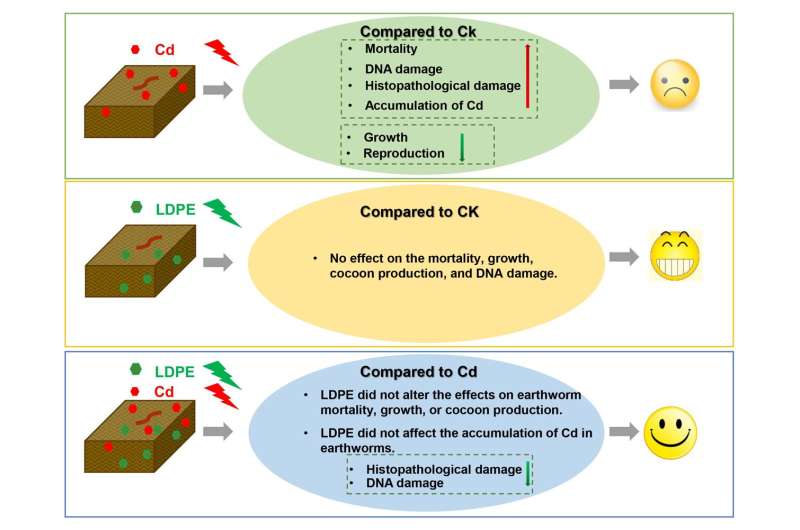This article has been reviewed according to Science X's editorial process and policies. Editors have highlighted the following attributes while ensuring the content's credibility:
fact-checked
proofread
Low-density polyethylene microplastics partially alleviate toxicological effects induced by Cd exposure in earthworms

Cadmium (Cd) can accumulate in the food chain, with serious impacts on human health and safety. Microplastics (MPs) such as low density polyethylene (LDPE) should be considered not only as a single pollutant but also as a carrier of other pollutants.
A study appearing in Soil Ecology Letters demonstrates that 313 mg/kg Cd inhibited growth and reproduction and damaged the microstructures of the skin and intestine. Meanwhile, LDPE had no effect on the mortality, growth, or cocoon production of earthworms. Moreover, it did not increase the mortality, growth, or inhibition of cocoon production caused by Cd and instead alleviated the DNA damage in coelomocytes caused by Cd treatment. Finally, it did not alter the accumulation of Cd in the worms.
A series of studies on the MPs caused a negative effect on the growth of earthworms, while biodegradable MPs had weaker negative impacts based on a meta-analysis. However, effects of MPs to earthworm remain controversial.
In one study, exposure of earthworms (Eisenia andrei) to polyethylene (PE) MPs for 28 days had no significant effects on the survival, number of juveniles and the final weight of adult earthworms. But long-term earthworm PE-MPs intake caused intestinal damage.
The results indicate that the toxicity of PE may be related to the exposure time. Moreover, the protective layer formed by soil particles on plastics decreases the toxicity of PE-MPs to earthworms. In another study, no significant effects were reported on the survival, number of juveniles, or weight of adult earthworms after exposure to various concentrations of MPs.
Professor Wang said, "To date, few studies have indicated that LDPE MPs do not increase the toxicity of Cd in earthworms, and thus our findings are inconsistent with recently published papers. We found that 30% LDPE had no effect on the mortality, growth, and cocoon production of earthworms.
"Moreover, LDPE did not increase the mortality, or the inhibition of growth and cocoon production caused by Cd. It alleviated the histopathological damage and DNA damage of coelomocytes to earthworms caused by Cd. The mRNA level of MT in earthworms increased with coexposure to LDPE and Cd. LDPE did not alter the accumulation of Cd in earthworms.
"Further studies are needed to elucidate why LDPE MPs did not increase the toxicity of Cd in earthworms. The indicators described here can be used for toxicity safety assessment and soil ecological risk assessment of soils contaminated with both MPs and heavy metals."
More information: Song Zhang et al, Low-density polyethylene microplastics partially alleviate the ecotoxicological effects induced by cadmium exposure on the earthworm Eisenia fetida, Soil Ecology Letters (2024). DOI: 10.1007/s42832-023-0184-4
Provided by Higher Education Press



















